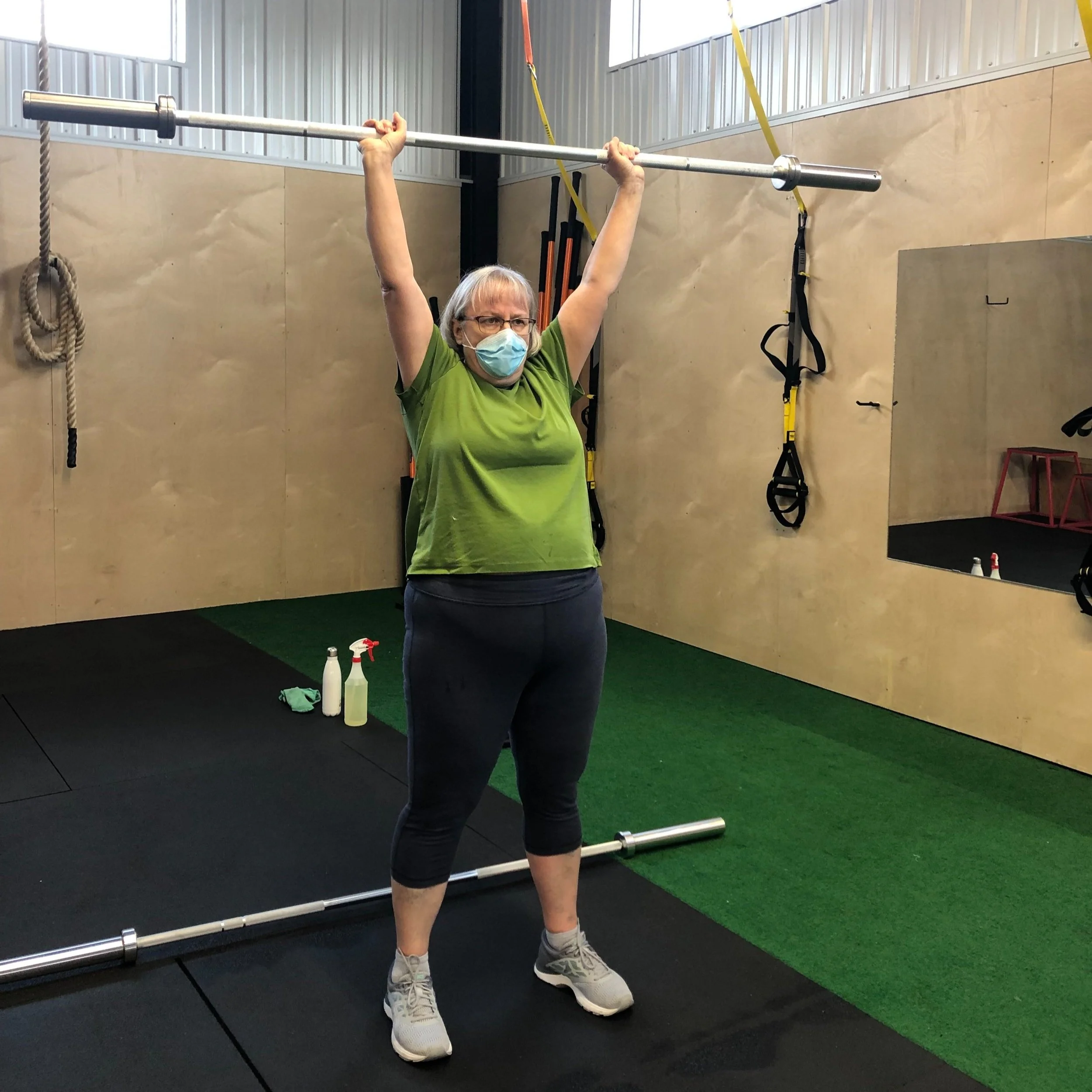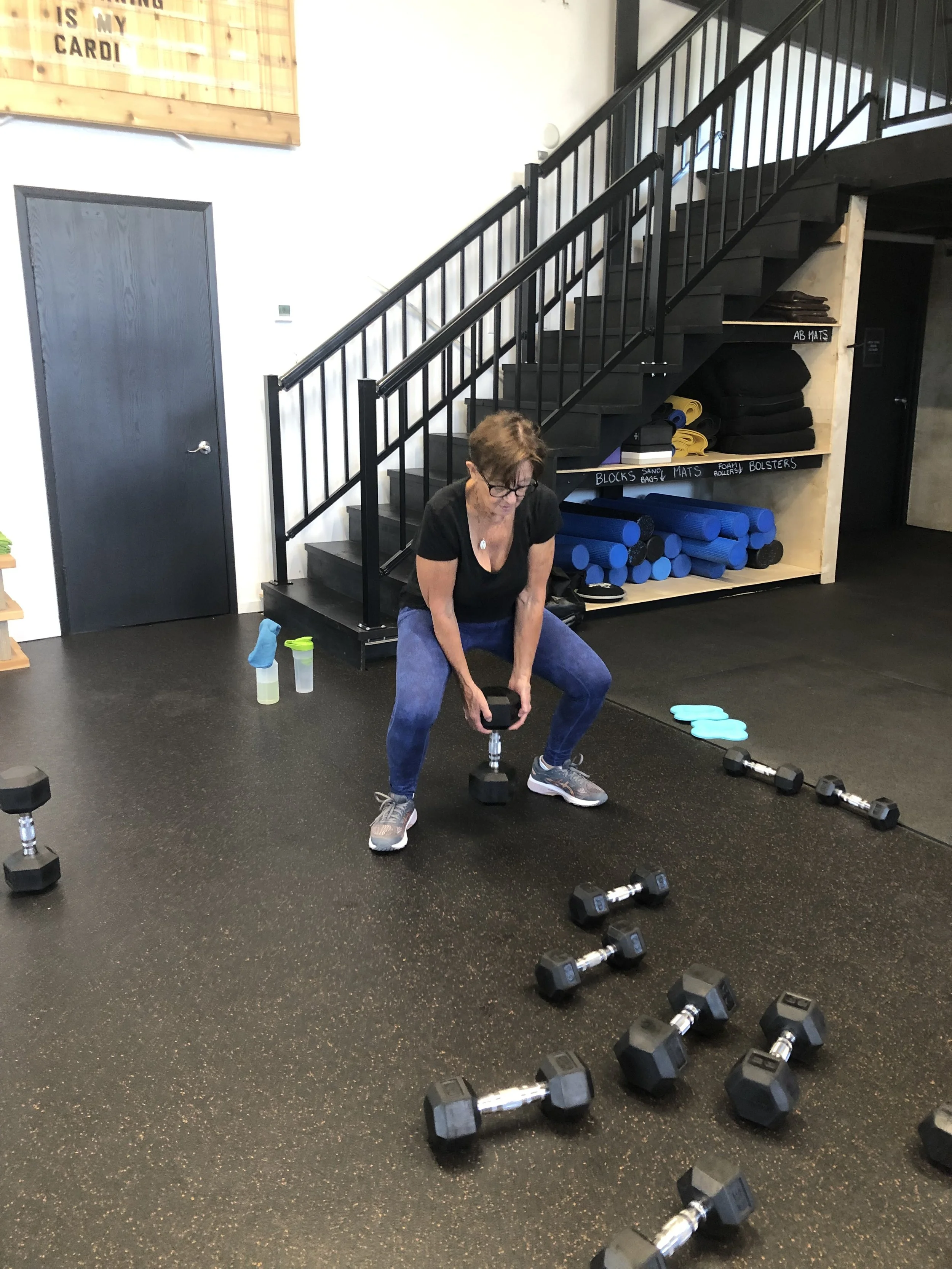Sandra, completing an overhead press to stay strong
When you don’t listen to what people tell you that you SHOULD do as you get older, you can be strong and active at any age.
What does healthy aging mean to you? Changes to your body as you get older are inevitable, but that does not mean you cannot enjoy an active, independent life. Modern medicine has done a wonderful job at keeping people alive longer, but equally important is the quality of life that can be enjoyed with those extra years.
We can use a concept called the heterogeneity of aging to describe the aging process. This means that while there are certain things that everyone can expect as they age, these do not happen at the same rate or to the same extent in each person. In other words, it would be impossible to predict someone’s function by knowing only their age. So what can you do to get yourself ready for a better future? Well, almost any part of the aging process can be combated with exercise, and it’s never too late to start!
One of the most important things you can do for your health as you age is resistance training. This involves strengthening your muscles and bones by moving your body against some sort of resistance such as resistance bands, weights, or machines. The Canadian Society for Exercise Physiology recommends resistance training for major muscle groups at least two times per week. Starting at age 30 we begin to gradually lose muscle mass, and when we reach 60 the rate at which we lose mass increases (Fragala et al., 2019). We lose strength 3-5 times faster than we lose muscle mass (Fragala et al., 2019). This is part of the aging process, but it doesn’t have to be this way. There is evidence that resistance training can help slow losses of muscle mass and strength. Upper and lower body strength can be improved by 9 to 174% and power can be improved by 14-97% with a properly designed resistance training program (Fragala et al., 2019). These may just look like numbers, but can have a huge impact on an adult’s ability to be independent. Most activities you do everyday require a certain amount of strength to do them. Resistance training can give you the boost in strength you need to do activities that you love and those that are necessary for daily life. Resistance training can also reduce the risk of falling and the risk of being injured if you do fall, and has psychological benefits such as improved mood and sleep in older adults. (Fragala, 2019). In addition to many proven benefits, lifting weights can be so satisfying and make you feel strong and capable.
If you think it's too late for you to start, just consider this study conducted in 1990 by Fiatarone et al. The subjects in this study were residents of a nursing home who were considered frail and the average age of these subjects was 90.
The “golden gals” jogging in a group fitness class.
Three days a week for 8 weeks, participants performed three sets of 8 repetitions on a leg extension machine. When they were tested again after 8 weeks, the average increase in strength was 174%! This type of improvement is generally unheard of in the general population, which shows that older adults have even greater potential to get stronger. This study showed that even adults who were too frail to live independently could greatly increase their strength, showing that it’s truly never too late to start!
One of the most important things you can do for your health as you age is resistance training. This involves strengthening your muscles and bones by moving your body against some sort of resistance such as resistance bands, weights, or machines. The Canadian Society for Exercise Physiology recommends resistance training for major muscle groups at least two times per week. Starting at age 30 we begin to gradually lose muscle mass, and when we reach 60 the rate at which we lose mass increases (Fragala et al., 2019). We lose strength 3-5 times faster than we lose muscle mass (Fragala et al., 2019). This is part of the aging process, but it doesn’t have to be this way. There is evidence that resistance training can help slow losses of muscle mass and strength. Upper and lower body strength can be improved by 9 to 174% and power can be improved by 14-97% with a properly designed resistance training program (Fragala et al., 2019). These may just look like numbers, but can have a huge impact on an adult’s ability to be independent. Most activities you do everyday require a certain amount of strength to do them. Resistance training can give you the boost in strength you need to do activities that you love and those that are necessary for daily life. Resistance training can also reduce the risk of falling and the risk of being injured if you do fall, and has psychological benefits such as improved mood and sleep in older adults. (Fragala, 2019). In addition to many proven benefits, lifting weights can be so satisfying and make you feel strong and capable.
If you think it's too late for you to start, just consider this study conducted in 1990 by Fiatarone et al. The subjects in this study were residents of a nursing home who were considered frail and the average age of these subjects was 90. Three days a week for 8 weeks, participants performed three sets of 8 repetitions on a leg extension machine. When they were tested again after 8 weeks, the average increase in strength was 174%! This type of improvement is generally unheard of in the general population, which shows that older adults have even greater potential to get stronger. This study showed that even adults who were too frail to live independently could greatly increase their strength, showing that it’s truly never too late to start!
Aerobic exercise is also very important because it can improve cardiovascular fitness, which is important for many activities of daily living. The Canadian Society for Exercise Physiology recommends 150 minutes per week of moderate to vigorous activity for adults aged 65 and over. Having low cardiovascular fitness means you may get out of breath before you are able to complete a task- whether that be chores such as dusting or vacuuming, or doing what you love such as playing with your grandkids or walking your dog. Walking, cross country skiing, biking, and anything that gets your heart rate up can improve your cardiovascular fitness. However, if you do not feel confident enough or are unable to do these activities, there are other options. You can even do a seated cardio workout from your chair!
So why doesn’t every adult exercise then? One problem is that as people get older, loved ones may prevent them from doing many activities in order to protect them. In a report written to highlight and overcome these attitudes, O’Brien Cousins (2005) explains why this may happen. “Young and old believe that older people shouldn’t be exerting themselves. Such activities are seen as too hard on the older body and might wear it out even faster” (O’Brien Cousins, 2005, p. 6). However, sitting around all day may be more dangerous than activity because it will lead to a further loss in fitness and independence. It is never too late to start exercising, and an exercise professional can help create an effective and safe program for you. Exercising can be a great way to pass the time, socialize, and get healthier. It can also help you live the life you want by increasing your independence and ability to do fun things. Being physically active does not have an expiration date.
Elaine came to us with the goal to get stronger and stay in shape as she ages. After 3 months of personal training to build her strength and endurance, she decided she was ready to transition into group fitness classes.
Even knowing the many benefits of exercise, it can be hard to know where to start. Personal training can be adapted to almost any ability and is a great way to ensure you are exercising in a safe and effective way. Group fitness classes can also be adapted if you are looking for a more social experience. We even have a few workout videos tailored specifically to older adults looking to regain or maintain strength, balance, and endurance. Whichever option you choose, you can be sure that the staff at Encompass will help you find a safe and effective way to get moving, because acting your age is overrated!
Not sure whether strength training would be appropriate for you or a parent of yours? Book a consultation in-person or via zoom to chat further and see if training to maintain strength and activities of daily living would be appropriate.
References:
To learn more about the 24 hour movement guidelines, visit CSEP’s website:
“Performing a variety of types and intensities of physical activity, which includes
Moderate to vigorous aerobic physical activities such that there is an accumulation of at least 150 minutes per week
Muscle strengthening activities using major muscle groups at least twice a week
Physical activities that challenge balance
Several hours of light physical activities, including standing”
Canadian Society for Exercise Physiology. Canadian 24 hour Movement Guidelines for Adults aged 65 and Older. https://csepguidelines.ca/adults-65/
Fragala, Maren S., Cadore, Eduardo L., Dorgo, S., Izquierdo, M., Kraemer, William J., Peterson, M., Ryan, E. (2019). Resistance Training for Older Adults: Position Statement From the National Strength and Conditioning Association, Journal of Strength and Conditioning Research, 33(8), 2019-2052 doi: 10.1519/JSC.0000000000003230
Fiatarone, M. A., Marks, E. C., Ryan, N. D., Meredith, C. N., Lipsitz, L. A., & Evans, W. J. (1990). High-intensity strength training in nonagenarians: effects on skeletal muscle. Jama, 263(22), 3029-3034.
O’Brien Cousins, C. (2005). Overcoming Ageism in Active Living. Report for the Active Aging Coalition for Older Adults. p. 1-22. https://www.activeagingcanada.ca/assets/pdf/ageism/overcoming_ageism.pdf
Written by Julia Verhelst, 2021 Intern, Encompass Fitness Studio


